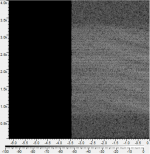KE7IZL
Member
I was tuned to 4.284MHz, and while using USB mode the signal was centered on an audio frequency of 2KHz, so that means in the RF spectrum the signal was centered at 4.286MHz. It appears to be a fairly wide band mode for HF transmissions, due to it being about 3Khz wide. It has a very flat top to its spectrum (suggesting it's using ODFM with multiple much narrower band carriers). Not sure the actual carrier modulation method but probably some kind of PSK or QAM. The signal's spectrum shows both overall fading, and selective fading, which means I'm getting the signal from ionospheric bounce from far away. Definitely not a local signal. I live in Seattle, but am not sure the typical range of bounced signals like this. Maybe a few hundred miles? Just recorded this signal tonight. I know for sure it's not in a ham radio band.
I've attached a copy of the WAV file and also a PNG spectrogram. Note that in this particular example, general fading isn't really present (I didn't capture a good example of the general fading) but selective fading can be easily heard and also seen in the spectrogram. I have the WAV file in a ZIP file due to not being allowed to attach a WAV file directly.
I've attached a copy of the WAV file and also a PNG spectrogram. Note that in this particular example, general fading isn't really present (I didn't capture a good example of the general fading) but selective fading can be easily heard and also seen in the spectrogram. I have the WAV file in a ZIP file due to not being allowed to attach a WAV file directly.


